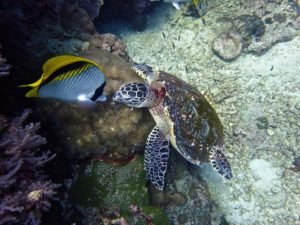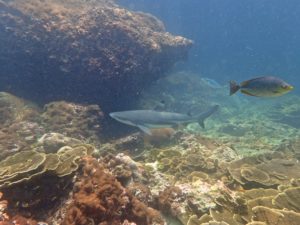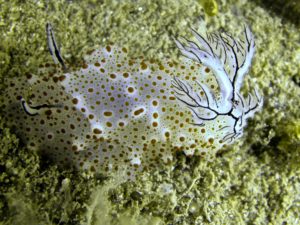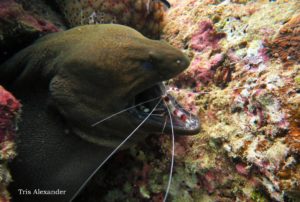Our Favourite Underwater Animals!
The rich waters of the Andaman Sea are a diver’s paradise and offer the opportunity to dive with a wide variety of Thailand marine creatures.
Here we list our top 10 favourite animals that can be encountered on a diving day trip or liveaboard experience from Phuket.
1. Manta Ray
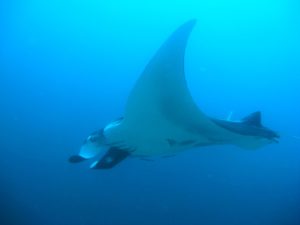
These beautiful, majestic creatures are are a wonderful sight to see and glide through the water so gracefully. An encounter is a real Thailand diving highlight, and we are lucky enough to get fairly frequent sightings.
Mantas are pelagic creatures that feed on plankton in the open sea but they regularly return to specific cleaning stations on the reefs and sometimes congregate in groups. They can often be seen in shallower waters so even beginner divers and snorkelers can be lucky enough to see one. These are giant animals that can reach up to 9 metres and can weight up to 2 tons. To dive with a manta ray is an unforgettable experience.
Dive sites:
Racha Noi, especially South Tip
Similans – Koh Bon, Koh Tachai and Richelieu Rock
Hin Daeng & Hin Muang
Time of year:
Phuket – all year round
Similans – Nov-April
Hin Daeng & Hin Muang – Nov-April
2. Whale Shark

The largest fish on the planet is high up on our list, and is another highlight for most divers. In Thailand there are sites where these sharks are seen fairly often however encounters cannot be guaranteed. If you are in the right place at the right time you may get lucky!
Although these are huge creatures that can grow up to 12 metres long we mostly encounter smaller juveniles. They are completely harmless and like manta rays, feed on plankton. They are the gentle giants of the Andaman Sea.
Dive sites:
Phi Phi Islands
Shark Point
Similan Islands – Richelieu Rock & Koh Tachai
Hin Daeng & Hin Muang
Time of year:
Phuket – all year round
Similans – Nov-April
Hin Daeng & Hin Muang – Nov-April
3. Leopard Shark
The most common species of shark in Thailand is the beautiful Leopard Shark. These docile, harmless sharks can often be found during the day resting on the sandy bottom, as they are largely nocturnal.
Contrary to most other sharks, leopard sharks are not afraid of divers which means we are often lucky enough to get really close. Leopard sharks are classified as ‘Vulnerable’ but there are conservation projects underway. You can help by sending in photos to Spot The Leopard Shark – Thailand.
Dive sites:
Racha Noi
Shark Point
Hin Bida Phi Phi Islands
Similans – Koh Tachai
Time of year:
Phuket – all year round but more likely May-Nov
Similans – Nov-April
4. Turtle
Turtles are another popular attraction when diving in Phuket. Most common are the Green Turtle and Hawksbill Turtle. They are reptiles which spend all of their life in the sea, popping up to the surface from time to time to breathe air. They grow very slowly taking about 15 years to reach maturity.
For us divers they are easily and frequently observed and are often seen munching on the corals on the reef.
Dive sites:
Racha Yai
Racha Noi
Phi Phi Islands – Turtle Wall, Koh Bida Nok
Similans, especially Donald Duck Bay
Koh Haa
Time of year:
Phuket – all year round
Similans – Nov-April
Koh Haa – Nov-May
5. Black Tip Reef Shark
The black tip reef shark is one of the most beautiful sharks in the sea and gets its name from the distinctive black markings on the fin tips especially the dorsal fin. Although they are shy of divers and always on the move they are easily recognised and often found in shallow water.
Even snorkelers get to see these wonderful creatures on our Phi Phi Islands day trips. They can reach a size of over 2 metres but are usually closer to 1.6 metres.
Dive sites:
Phi Phi Islands – Koh Bida Nok, Koh Bida Nai and Palong Bay
Time of year:
All year round
6. Seahorse
Always a beautiful sight to spot a seahorse and we are lucky to have several species here, the most common being the Tiger Tail seahorse.
If you are an underwater photography fan then please don’t use your flash. Seahorses are very sensitive to light and the camera flash can cause stress as well as damage to their eyes. We like to be respectful of our seahorses so they will be around for a long time to come.
Dive Sites:
Anemone Reef
Shark Point
Koh Dok Mai
Phi Phi Islands
Similans – Richelieu Rock
Time of year:
All year round
Richelieu – Nov-Apr
7. Anemonefish
The Anemonefish, or Clownfish is a tiny fish that shares an amazing symbiotic partnership with another sea creature; the anemone – hence the fish being named an anemonefish. Anemones have tentacles that sting, but the clownfish is immune to that. The sea anemone protects the anemonefish from predators, as well as providing food through the scraps left from the anemone’s meals and occasional dead anemone tentacles. In return, the anemonefish defends the anemone from its predators, and also parasites.
There are 30 species of anemonefish, ranging in size from 10cm to 18cm, and they come in various colours, such as pink, red, yellow, black and brown often with white stripes or patches. The four we commonly see here diving Phuket are the False Clownfish, Skunk Anemonefish, Clark’s Anemonefish and Tomato Anemonefish.
Dive sites:
All, especially Anemone Reef, Shark Point & Similans – Richelieu Rock
Time of year:
Phuket – all year round
Similans – Nov-Apr
8. Nudibranchs
Nudibranchs are some of the most colourful creatures on earth. They are a group of soft-bodied, marine gastropod molluscs which shed their shells after their larval stage. During their evolution of losing the shell they have developed vibrant colours and striking forms as an alternative defence mechanism.
Thailand is home to a large variety of nudibranchs and are very popular with divers, especially macro lovers. We often see the Harlequin Nudibranch, Blue Dragon and Varicose Wart among others.
Dive sites:
All, especially King Cruiser wreck, Koh Dok Mai, Elephant Head Rock and Boonsung wreck at the Similans
Time of year:
All year round
9. Moray Eel
We love moray eels! Although they have a slightly scary appearance and some people are wary of them, they are not aggressive to divers unless they are provoked or harrassed.
There are many species in different sizes. In Thailand, the most common are the small White-Eyed morays and the Giant moray eel. But Starry morays and Zebra morays are also regularly seen, as well as Finbriated morays.
Dive sites:
All, especially Shark Point, Anemone Reef & Similans – Boonsung wreck.
Time of year:
Phuket – all year round
Similans – Nov-Apr
10. Frogfish
These amazing little creatures are excellent camouflage artists, and well hidden in the reef so it is always a delight to find one! They come in a variety of colours including white, red, yellow, green and brown to perfectly blend into their environment, and have been known to change colour.
They can grow up to 30+cm large but the ones we generally see are smaller at between 3-10cm. Frogfish typically move slowly, lie in wait for prey and then strike extremely fast in as little as 6 milliseconds!
Dive sites:
Racha No – Racha Noi Bay & Banana Rock
Similans & Richelieu Rock
Time of year:
Phuket – all year round
Similans – Nov-April
So these are our top ten favourite thailand marine creatures but there are lots more to see and an amazing variety of marine life in Thailand. The Andaman Sea has an incredible diversity and there is plenty more to await you: corals in all shapes, sizes and colours; sea fans; tiny shrimps and crabs; huge schools of snapper and fusiliers; trevallies and tuna on the hunt; and tropical reefish such as batfish, squirrelfish, parrotfish, angelfish and sweetlips.
So if you’d like to dive with us in Phuket then don’t hesitate to contact us. Our Instructors are experienced, friendly and adaptable so you can dive at your own pace, taking your time to observe and enjoy the amazing underwater world!
For additional information or to book a Phuket diving or snorkeling trip enquire here


